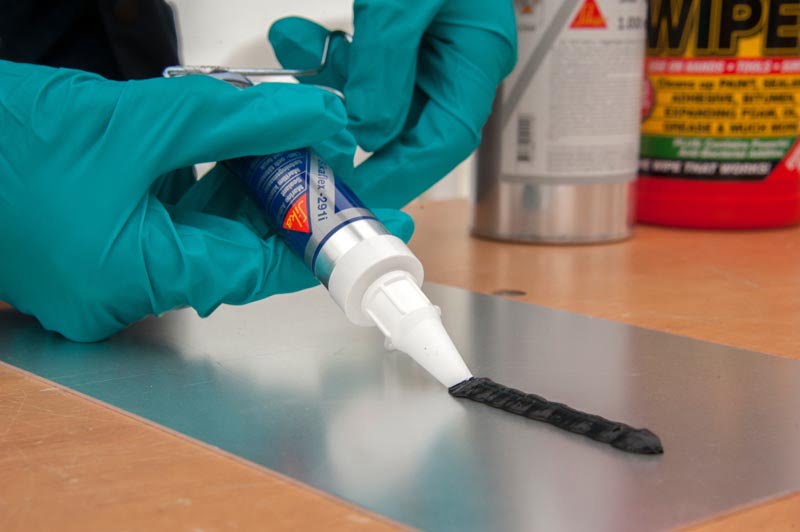The early spring rush to prepare boats to be water-tight and in top condition for another season on the water is upon us with thousands of boat owners around the country already embarking on a host of jobs from anti-fouling to fixing leaky windows. If the work involves sealing or bonding, the chances are Sikaflex® is at the top of their wish list.
Gareth Ross, Marine Market Field Specialist for Sika UK, shares his technical expertise to help achieve the best results when carrying out minor jobs involving with sealants.
Tip #1: All substrates should be prepared with cleaners and primers before applying the sealant or bonding product.
A hot topic at any of Sika’s demonstrations at boat shows and other events is surface preparation. Sika always advises boat owners to prepare the surface as this is important to laying the foundation for a properly bonded or sealed substrate. Depending on the substrate, the preparation prior to applying the primer will vary. For instance, when making a teak deck repair, after removing the old sealant completely, the type of sealant should be identified before dry fitting the new plank in situ to ensure that it will sit neatly with the existing planks. The substrate is then cleaned before priming.
There are a variety of primers available to suit specific repair jobs and Sika offers Multiprimer Marine, which was developed to improve adhesion and can be used on all non-glazing tasks. The primer is easily applied by brush and the adhesive or sealant can typically be applied after just 30 minutes (when in conditions above 15°C), helping to save time.
Tip #2: Use the sealant cartridge nozzle to create the right shape bead for the task
When ready to start applying the sealant or bonding product, there are different shape beads that can be created by changing the profile of the cartridge nozzle and Sika experts can provide advice on how the product is applied to the surface. For instance, if sealing with Sikaflex® -291i it is recommended that a round bead is created using the standard shape of the nozzle because this provides a thick layer of sealant to the area and thus prevents water ingress. However, if bonding two substrates together with Sikaflex® adhesives, a triangular bead, formed by making a V cut into the cartridge nozzle will ensure that both substrates are perfectly wetted out with the adhesive, guaranteeing a robust bondline.
Tip #3: Repairing Leaky Windows
There are few problems that can cause more damage to a boat than window, porthole and hatch leaks. Even well-constructed boats will eventually develop leaks simply because boats are not totally rigid structures. Repairing a leaky window is a common pre-season job for boat owners and taking the time to do it properly will pay dividends and save time in the long run by making it water-tight for much longer.
Before choosing your sealant, you will need to identify whether your windows are made of organic glass, such as Perspex or mineral glass, which is the common glass that shatters. Sika has developed two sealants specifically for both types of marine glazing. Sikaflex-295 UV has been developed to bond and seal plastic marine glazing materials and because of its excellent UV resistance it can be used to seal joints in areas of severe exposure. Sikaflex-296 is suitable for use with all types of mineral glass-based windows. When working out the bond line configuration on plastic windows, it is important to bear in mind that they have more of a high thermal movement, which creates stress in the bond line. Additionally dynamic stress due to boat movement and wind load has to be taken into consideration. As with conventional glass, plastic glazing panels generally do not protect the adhesive face from damage by UV radiation, therefore the bond line must be protected from direct sunlight.
Tip #4: Extend the life of your sealant
Once all of your sealing and bonding jobs are complete, there may still be some product remaining in the cartridge. This does not need to be thrown away and can be kept for the odd repair that may crop up over the season. Simply keep the cartridge in a cool and dry place to slow down the curing process as hot and humid conditions will encourage moisture curing. Alternatively, if you don’t have much space on board, Sika® has developed a 70ml tube of its Sikaflex®-291i adhesive sealant, which helps reduce leftover product when only small amounts of sealant are needed.
Tip #5: Once of Sika’s most commonly asked questions by customers is how to remove Sikaflex®
Sikaflex® is a polyurethane technology, developed to produce a strong and long-lasting bond, unlike some silicone technologies, it’s ideal for applications that do not need repeating on a seasonal basis. Uncured Sikaflex® can easily be removed by using Sika® hand wipes or Sika® Everbuild® Wonderwipes®, usually this is within the first few minutes of applying the product. In terms of removing cured Sikaflex®, this depends entirely on where it is applied. However generally speaking, cured Sikaflex® can only be removed mechanically i.e. a sharp knife, vibra saw, cheese wire or abrading it off with a sander. Sika® Remover-208 can be used to remove uncured excess material of Sikaflex® adhesive or sealant from application tools or from soiled surfaces. If the product has cured Sika® Remover-208 will not get rid of the Sikaflex®.
Gareth Ross will on hand and offering lots more advice at Practical Boat Owner’s ‘Ask the Experts’ event during the Beaulieu Boat Jumble on 24th April.
For extensive information on Sika products, including step-by-step application instructions, please see the product data and H&S information sheets at www.sikamarine.co.uk. For more advice on priming, applying and storing Sika products please contact Sika on 01707 394444.

